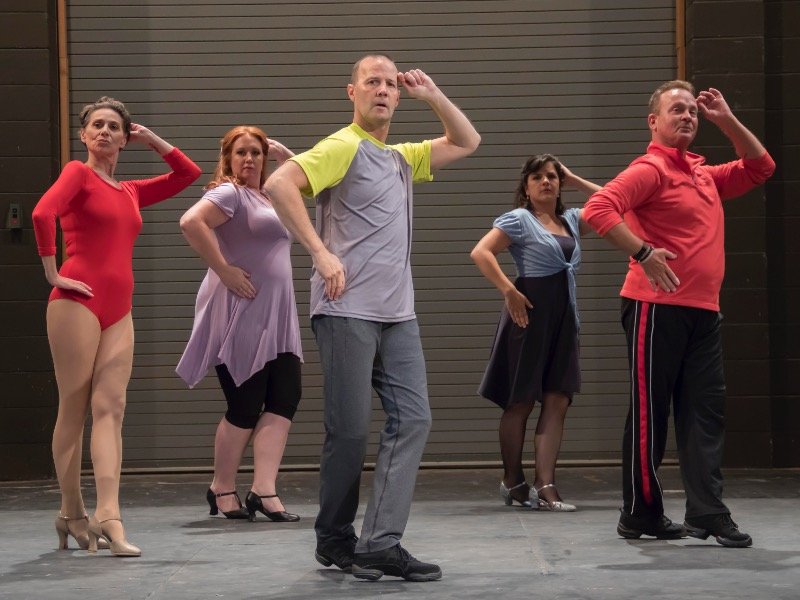"A Chorus Line," like a lot of musicals and movies about show business, focuses on a group of performers who are desperate to "make it" – to nail the audition, get into the show and finally begin their careers in the spotlight. Those are the stories of 20-somethings who have followed their hearts to open calls and audition rooms, working furiously to make the dream of stardom a reality.
But what happens after that? What happens when you’re 40 and still going to cattle calls, hoping to be chosen out of the crowd? What if success is hard to measure, or fame is fleeting? How long do you keep trying? As Zach, the director asks auditioners in "A Chorus Line," what would you do if you couldn’t perform anymore?
These questions are given an interesting spin in an unorthodox semi-staged production of the classic Michael Bennett musical, a joint venture by Milwaukee Opera Theatre and Theatre RED, with a very limited run – it opened last night and closes tonight. With a cast that reads like a who’s who of the Milwaukee theater scene, it features very talented performers — most of whom have aged out of the roles they are playing by a decade or two, and don’t have the toned, lithe figures of professional dancers. What they do have is passion, determination and the perspective that experience brings. The juxtaposition is illuminating.
Pre-show, the performers set the scene. On a bare stage, the dancers gather to warm up, psych themselves up for the audition and learn the choreography for Marvin Hamlisch’s iconic song "One." The dancers take deep breaths, laugh nervously and try to shake the anxiety out of their hands. They all have extra adrenaline running through their veins.
They all also have scripts and music stands in front of them because this is a reading with costumes and some choreography instead of a full production. After only one week of rehearsal, the cast of "A Chorus Line" is allowed to follow along with the score when they need to, and soon the convention is barely noticeable. Director Jill Anna Ponasik actually embraces the extra challenge and uses the stands and scripts to surprisingly great effect in the staging.
In the group of 17 auditioners, all the characters are hoping to stand out enough to catch the director’s eye and get cast. In the production, which is vocally uneven and could really benefit from body mics, some of the actors do stand out from the rest.
In a lipstick red leotard and a defiant pose, Angela Iannone is hard to ignore as Sheila, a role she has played before. As the snarky Broadway veteran who is bitter about turning 30, Iannone gets a lot of laughs, since she is well past that age. But as a performer who has appeared on Milwaukee stages season after season, she also gets a lot of props for her fierce devotion to her art.
David Flores delights as Mike, a guy who jumped at the chance to take dance lessons when his sisters lost interest. Reprising the role 30 years after he first played it, Flores still has impressive tap dance moves and a winning voice that carries "I Can Do That" – one of the only unabashedly upbeat numbers in the show.
Another scene stealer is Marcee Doherty-Elst, co-founder of Theatre RED, who creates a vibrant Val, the flat-chested chorus girl who realizes that plastic surgery is the key for her getting cast in New York. Her exuberant anthem to "tits and ass" is especially fun since, for once, it’s sung by a girl with real curves. She flaunts everything she’s got, and it is fabulous.
Karen Estrada is adorable as Kristine, the shy dancer who gets tongue-tied when the director asks her questions. Hiding behind her music stand or retreating into the safe embrace of her character’s husband Al (a boisterous Doug Jarecki) Estrada is pitch perfect as the pitch-challenged dancer who can’t really sing. By contrast, Rana Roman shows off her clear, angelic voice in two numbers, one about a horrendous acting teacher and the beautiful ballad, "What I Did for Love." Vocally, she is a highlight of the show.
As Zach and Cassie, Joe Picchetti and Beth Mulkerron bring real friction to their scenes onstage when the washed-up dancer pleads with her director ex-boyfriend for a chance to try out for the chorus of his show. In a clever addition to Cassie’s song about her relentless need to perform – "The Music and the Mirror" – the audience is treated to a montage of performance stills from the cast’s long careers, chronicling their lives in theater. Again, the context of using performers with very long resumes really adds depth to portions of the show.
The show’s most poignant moment belonged to Milwaukee Chamber Theatre Artistic Director C. Michael Wright, who has been performing onstage, directing plays and leading his own company for 40 years. He pours all that experience into playing Paul, a young gay man who is trying to figure out who he is, where he fits in and how dance can help him find a community. Alone onstage, he shoves his hands in his pockets nervously, his fingers fluttering to his mouth, then running through his hair as he tells the painful story of coming out to his parents. In this monologue, Wright is simply stunning.
So, does the conceit of staging "Chorus Line" without much dancing work? Yes and no. It absolutely helps the audience focus on the stories in the show, which are by turns amusing and compelling. But it also feels like something’s missing at the end of the night. The choreographed finale highlights what’s not in the show, rather than compensating for it.
But is it refreshing to see a diverse group of performers take on roles normally reserved for the young and buff? Absolutely. Kudos to both companies for "one singular interpretation."







